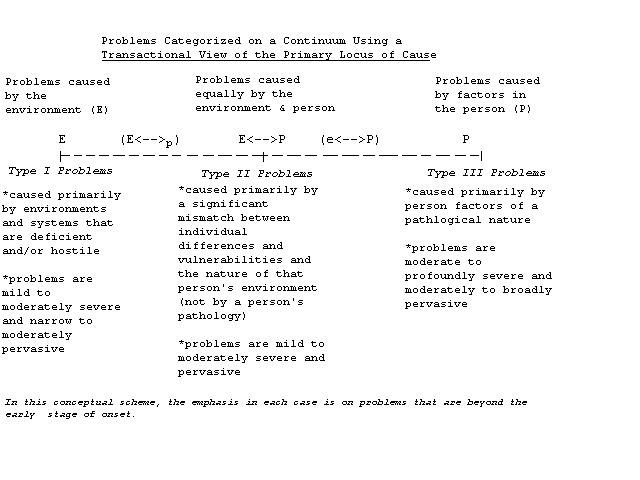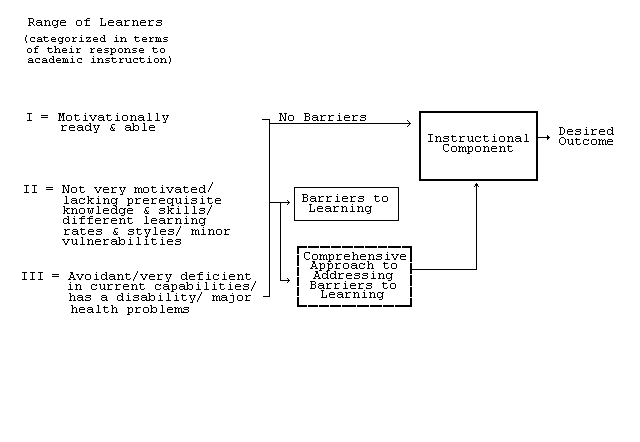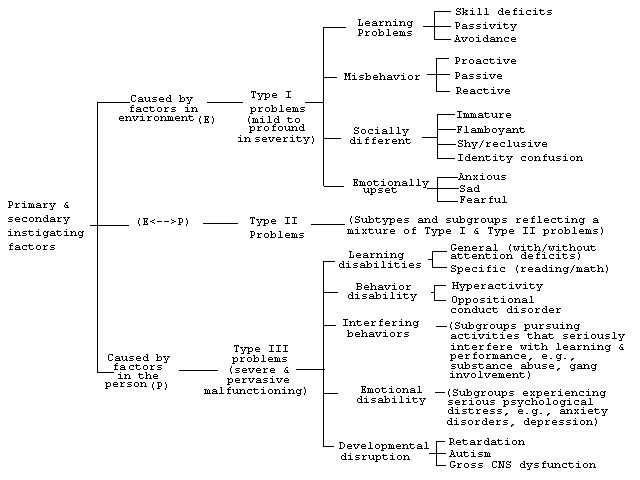Meeting Mandates: Necessary...but Insufficient and Often Unsatisfying
The following are some of the typical tasks assigned to school nurses, psychologists,
social workers, counselors, and other specialists:
- appraisal of new enrollees
- physical health, dental, and vision screening as mandated
- assessment of students referred for special education placement
- screening and reporting for suspected child abuse
- screening and referral for suspected substance abuse
- assessment and follow-up to control communicable (including sexually transmitted)
diseases
- physical and mental health education
- emergency care when major physical or mental health problems arise
- participation in emergency and crisis planning (e.g., planning for how the school should
respond to fires, floods, earthquakes, acts of violence and their aftermath)
And of course the ever present "Other tasks as assigned."
These tasks require use of assessment, counseling, referral, consultation, monitoring,
follow-up, information dissemination, and clerical skills related to remedial and
preventive health concerns. They involve interactions with students, families, school
staff, and professionals in the community.
Anyone seeing a school "support" staff in action as they pursue their many
tasks knows they are more than busy.
Anyone who talks with enough school support staff also knows that they are inundated
with referrals for students whose problems stem from a variety of physical and mental
health concerns.
Many school support staff want to redesign their roles so that much of the clerical and
assessment activity related to "mandates" can be streamlined. This would allow
them to perform an array of other functions that their training and expertise indicate
they are capable of doing. It would allow them to work more intensively with others at a
school site to maximize the impact schools have on addressing the most profound barriers
causing students to fall by the wayside. And all this has the potential not only to
enhance the success of a great many more students, but also should prove more satisfying
to the professionals involved.
How can this be done? "Not by working harder, but by working smarter."
One essential element in working smarter is to have an enhanced conceptual base that
can increase effectiveness. And one of the essential elements of such a conceptual base is
accounting for a full range of factors that cause students to have problems.
Return to
Understanding What Causes Different Types of Problems
Before the 1920s, the tendency was to view human behavior as determined primarily by
something within the person, especially inborn characteristics. As the psychological
school of thought known as behaviorism gained in influence, a strong competing view
arose. Behavior was seen as shaped by environmental influences, particularly the stimuli
and reinforcers one encounters.
Today, human functioning is viewed in transactional terms -- as the product of a
reciprocal interplay between person and environment. However, prevailing approaches to
labeling and addressing human problems still create the impression that problems are
determined by either person or environment variables.
This is both unfortunate and unnecessary -- unfortunate because such a view limits
progress in practice and research, unnecessary because a transactional view encompasses
the position that problems may be caused by person, environment, or both. This broad
paradigm encourages a comprehensive perspective of cause and correction.
The following is a way to think about the implications of a broad framework for
understanding the causes of students' problems.
This way of thinking offers a useful starting place for classifying behavioral,
emotional, and learning problems and helps avoid overdiagnosing internal pathology.
As illustrated below, such problems can be differentiated along a continuum that
separates those caused by internal factors, environmental variables, or a combination of
both.

To highlight a few points about the illustration:
Problems caused by the environment are placed at one end of the continuum and referred
to as Type I problems.
At the other end are problems caused primarily by pathology within the person; these
are designated as Type III problems.
In the middle are problems stemming from a relatively equal contribution of
environmental and person sources, labelled Type II problems.
Also note that in this scheme, diagnostic labels denoting extremely dysfunctional
problems caused by pathological conditions within a person are reserved for
individuals who fit the Type III category.
Obviously, some problems caused by pathological conditions within a person are not
manifested in severe, pervasive ways, and there are persons without such pathology whose
problems do become severe and pervasive. The intent is not to ignore these individuals. As
a first categorization step, however, it is essential they not be confused with those seen
as having Type III problems.
At the other end of the continuum are individuals with problems arising from factors
outside the person (i.e., Type I problems). Many people grow up in impoverished and
hostile environmental circumstances. Such conditions should be considered first in
hypothesizing what initially caused the individual's behavioral, emotional, and learning
problems. (After environmental causes are ruled out, hypotheses about internal pathology
become more viable.)
To provide a reference point in the middle of the continuum, a Type II category is
used. This group consists of persons who do not function well in situations where their
individual differences and minor vulnerabilities are poorly accommodated or are responded
to hostilely. The problems of an individual in this group are a relatively equal product
of person characteristics and failure of the environment to accommodate that individual.
There are, of course, variations along the continuum that do not precisely fit a
category. That is, at each point between the extreme ends, environment-person transactions
are the cause, but the degree to which each contributes to the problem varies. Toward the
environment end of the continuum, environmental factors play a bigger role (represented as
E<--->p). Toward the other end, person variables account for more of the problem (thus e<--->P).
Clearly, a simple continuum cannot do justice to the complexities associated with
labeling and differentiating psychopathology and psychosocial problems.
Furthermore, some problems are not easily assessed or do not fall readily into a group
due to a lack of information and comorbidity.
Starting with a broad model of cause, however, helps practitioners counter tendencies
to prematurely conclude that a problem is caused by pathology within the individual and
thus helps avoid blaming the victim (Ryan, 1971).
It also helps highlight the notion that improving the way the environment accommodates
individual differences may be a sufficient intervention strategy.
Clinical Approaches at School Sites
All schools have and benefit from counseling, psychological, and social service
interventions and want more.
Some of the services are provided by nurses and other student services professionals
hired by the school district.
In addition, a few community services are appearing on campuses as part of the effort
to base some of these at school sites.
For many years, clinical approaches in school settings were offered in a practitioner's
office and carried out in relative isolation of other interventions aimed at a student and
her or his family.
Recently, efforts to increase the range of services
at school sites and to coordinate such
efforts has led to an expanded number of
school-based health centers and family service centers.
Return to
School-Based Health Centers
Many of the now over 1,000 school-based or linked health clinics are described as
comprehensive centers (Advocates for Youth, 1994; Dryfoos, 1994; Robert Wood Johnson
Foundation, 1993; Schlitt, Rickett, Montgomery, & Lear, 1994). This reflects the fact
that the problems students bring to such clinics require much more than medical
intervention.
Click here to read: The school based clinic movement... (A new page will open)
Return to
Contents of Section C
Family Service Centers and Full Service Schools
Dryfoos (1994, 1995) encompasses the trend to develop school-based primary health
clinics, youth service programs, community schools, and other similar activity under the
rubric of full service schools. (She credits the term to Florida's comprehensive
school-based legislation.)
As she notes in her review:
Much of the rhetoric in support of the full service schools concept has been presented
in the language of systems change, calling for radical reform of the way educational,
health, and welfare agencies provide services. Consensus has formed around the goals of
one stop, seamless service provision, whether in a school- or community-based agency,
along with empowerment of the target population. ... most of the programs have moved
services from one place to another; for example, a medical unit from a hospital or health
department relocates into a school through a contractual agreement, or staff of a
community mental health center is reassigned to a school, or a grant to a school creates a
coordinator in a center. As the program expands, the center staff work with the school to
draw in additional services, fostering more contracts between the schools and community
agencies. But few of the school systems or the agencies have changed their governance. The
outside agency is not involved in school restructuring or school policy, nor is the school
system involved in the governance of the provider agency. The result is not yet a new
organizational entity, but the school is an improved institution and on the path to
becoming a different kind of institution that is significantly responsive to the needs of
the community (p. 169).
Full service schools reflect the desire for comprehensiveness; the reality remains much
less than the vision. As long as such efforts are shaped primarily by a school-linked
services model (i.e., initiatives to restructure to community health and human services),
resources will remain too limited to allow for a comprehensive continuum of programs.
And in their struggle to find ways to finance programs for troubled and troubling
youth,community agencies and schools are forced to tap into resources that require
assigning youngsters labels that convey severe pathology. Reimbursement for mental health
and special education interventions is tied to such diagnoses. This fact dramatically
illustrates how social policy shapes decisions about who receives assistance and the ways
in which problems are addressed. It also represents a major ethical dilemma for
practitioners. That dilemma is not whether to use labels, but rather how to resist the
pressure to inappropriately use those labels that yield reimbursement from third party
payers.
Return to
Programmatic Approaches:
Going Beyond Clinical Interventions to Address the Full Range of Problems
A large number of young people are unhappy and emotionally upset; only a small
percent are clinically depressed. A large number of youngsters behave in ways that
distress others; only a small percent have ADHD or a conduct disorder. In some schools,
the majority of students have garden variety learning problems; only a few have learning
disabilities. Thankfully, those suffering from true internal pathology (those referred to
here as Type III problems) represent a relatively small segment of the population. Society
must never stop providing the best services it can for such individuals and doing so means
taking great care not to misdiagnose others whose "symptoms" may be similar but
are caused to a significant degree by factors other than internal pathology (those
referred to above as Type I and II problems). Such misdiagnoses lead to policies and
practices that exhaust available resources in serving a relatively small percent of those
in need. That is a major reason why there are so few resources to address the barriers
interfering with the education and healthy development of so many youngsters who are seen
as troubled and troubling.
Because behavior, emotional, and learning problems usually are labelled in ways that
overemphasize internal pathology, it is not surprising that helping strategies take the
form of clinical/remedial intervention. And for the most part, such interventions are
developed and function in relative isolation of each other.
Thus, they represent another instance of using piecemeal and fragmented strategies to
address complex problems.
One result is that an individual identified as having several problems may be involved
in programs with several professionals working independently of each other. Similarly, a
youngster identified and treated in special infant and pre-school programs who still
requires special support may cease to receive appropriate help upon entering school. And
so forth.
Dealing with the full continuum of Type I, II, and III problems requires a
comprehensive and integrated programmatic approach. Such an approach may require one or
more mental health, physical health, and social services. That is, any one of the problems
may require the efforts of several programs, concurrently and over time. This is even more
likely to be the case when an individual has more than one problem. And, in any instance
where more than one program is indicated, it is evident that interventions should be
coordinated and, if feasible, integrated.
Needed: A Full Continuum of Programs and Services
School health programs always have been concerned with more than offering clinical
services. And over the last decade, leaders in the field have advocated for an eight
component model to ensure schools have a comprehensive focus on health (Allensworth &
Kolbe, 1987; Kolbe, 1986). The components are (1) health education, (2) health services,
(3) biophysical and psychosocial environments, (4) counseling, psychological, and social
services, (5) integrated efforts of schools and communities to improve health, (6) food
service, (7) physical education and physical activity, and (8) health programs for faculty
and staff.
The focus on comprehensive school health is admirable. It is not, of course, a
comprehensive approach for addressing a full range of barriers to learning -- nor does it
profess to be. Moreover, its restricted emphasis on health tends to engender resistance
from school policy makers who do not think they can afford a comprehensive focus on health
and still accomplish their primary mission to educate students.
Reform-minded policy makers may be more open to proposals encompassing a broad range of
programs to enhance healthy development if such programs are part of a comprehensive
approach for addressing barriers to learning.
Some are suggesting that the school-linked services movement, especially in the form of
full service schools is the answer. And each day brings additional reports from projects
such as New Jersey's School-Based Youth Services Program, the Healthy Start Initiative in
California, the Beacons Schools in New York, Cities-in-Schools, and the New Futures
Initiative.
A review by Michael Knapp (1995) underscores the fact that the literature on
school-linked services is heavy on advocacy and prescription and light on findings. Not
surprisingly, findings primarily reflect how hard it is to institutionalize such
approaches. �
Keeping the difficulties in mind, a reasonable inference from available data is that
school-community collaborations can be successful and cost effective over the long-run.
Outstationing community agency staff at schools allows easier access for students and
families -- especially in areas with underserved and hard to reach populations. Such
efforts not only provide services, they seem to encourage schools to open their doors in
ways that enhance family involvement. Analyses suggest better outcomes are associated with
empowering children and families and having the capability to address diverse
constituencies and contexts. Families using school-based centers are described as becoming
interested in contributing to school and community by providing social support networks
for new students and families, teaching each other coping skills, participating in school
governance, and helping create a psychological sense of community.
At the same time, it is clear that initiatives for school-linked services produce
tension between school district pupil services personnel and their counterparts in
community-based organizations.
When "outside" professionals are brought in, school specialist staff often
view the move as discounting their skills and threatening their jobs. These concerns are
aggravated whenever policy makers appear to overestimate the promise of school-linked
services with regard to addressing the full range of barriers to learning. And,
ironically, by downplaying school-owned resources, the school-linked services movement has
allowed educators to ignore the need for restructuring the various education support
programs and services that schools own and operate.
A continuum is outlined on the following page to illustrate the comprehensive range of
programs needed to address Type I, II, and III problems.
Such an approach recognizes the role school, home, and community life play in creating
and correcting young people's problems, especially those who are under-served and
hard-to-reach.
From such a perspective, schools must provide interventions that address individual
problems and system changes. At the same time, schools must continue to explore formal and
informal ways to link with public and private community agencies.
![]() state several implications of understanding students' problems in
terms of a causal continuum that ranges from internal to external causes
state several implications of understanding students' problems in
terms of a causal continuum that ranges from internal to external causes![]() identify two major reasons why school-based health centers have
come to find it necessary to address mental health and psychosocial concerns
identify two major reasons why school-based health centers have
come to find it necessary to address mental health and psychosocial concerns![]() understand the difference between a comprehensive school health
program and a comprehensive approach for addressing barriers to learning
understand the difference between a comprehensive school health
program and a comprehensive approach for addressing barriers to learning 


